Wellings, William (McKechnie Section 2)
See also Section Five
Recorded by Jackson (Dictionary), who states that Wellings lived for fourteen years at 3 Tavistock Row, London, and then, in October 1792, advertised his move to Henrietta Street. She quotes the whole of this advertisement:
Mr. Wellings, Miniature Painter. Removed from No. 3, Tavistock Row to No. 26, Henrietta Street, Covent Garden. The Original Person that introduced the so much approved and admired Light Shades in the Profiles, thereby giving them an Elegance of appearance and expressing the Drapery and Dress in a style totally peculiar to himself alone, and has had the honour and happiness to meet with the approbation and patronage of the first Personages and greatest judges in the three Kingdoms during the fourteen years of his residence at Mrs. Sledges' in the above street. He most respectfully informs the Nobility and Gentry and the Public in general that he will continue to Paint Portraits in miniature, for Lockets, Bracelets, Rings, and Fausse Montres, in whole lengths, coloured or black, shaded or plain. Blocks, Busts, Conversations &c., in the most elegant manner. Specimens to be seen by applying above. Theatrical Portraits finished in any character required on a few days' notice.
NB. Large Shades reduced to any size.
Tavistock Row was the name given to the row of houses along the south side of the Piazza, as the square in which Covent Garden Market was for long situated was then known. Since Henrietta Street was a continuation of this row, Wellings's move to this street involved a move to an address only a few doors westwards.
The entries for St Paul's in the rate books for Covent Garden for the years 1780-92 contain no reference to the names of either Wellings or Sledge. It would seem, therefore, that neither Mrs Sledge nor Wellings owned the house in Tavistock Row, though the details about S. Sledge given below suggest that both he and Mrs Sledge moved to the Henrietta Street address at the same time as Wellings. Possibly Wellings and Mrs Sledge were living together, and S. Sledge may have been their son.
William Wellings, however, is recorded as the ratepayer for 26 Henrietta Street for the years 1792-94. The probability that members of the Sledge family lived at this address during these years is suggested by the fact that a silhouette, described as painted in the style of Wellings and bearing a trade label worded 'S. Sledge, Henrietta Street', is known to have existed. The artist may have been a son of Mrs Sledge, for, if Mrs Sledge's husband had been living at the Tavistock Row address when the advertisement was published, his name, not that of his wife, would have been mentioned as the householder. (See the entry on S. Sledge, who has not previously been documented as a silhouette artist).
There is no evidence that Wellings produced any silhouettes before 1778, which appears to be the year when his stay at 3 Tavistock Row began. One of his earliest known signed profiles is the full-length silhouette of William Pitt, dated 1781. This very fine piece is illustrated in Chapter Four.
104
Other full-length profiles by Wellings (both group and single-figure compositions) are illustrated in this Section. Most of these bear the artist's signature, and the attribution of the others to Wellings appears to be beyond doubt. Perhaps the best known and most often illustrated example is the silhouette in the Victoria and Albert Museum, London, which shows two ladies seated at a table. The figure on the left holds a book; the figure on the right, her spectacles, since, to judge from the open work-box on the table, she has apparently stopped sewing for a moment to listen to her daughter(?) reading.
957
The silhouette is not painted in nearly such deep shades of black as a photograph might suggest. Measuring 7¾ x 9¾ in., it is small in comparison with Torond's Mr and Mrs Smith of Hailsham with Aunt Everard. It is painted in varying shades of thinned black water-colour, with a brush of medium size; laces are shown by thickish dots against a pale wash background. Most similar groups by Torond are painted not in his clare-obscure style, but in solid black, detail being rendered only outside the main body of the profile.
912
Wellings, on the other hand, painted a good deal of costume detail, as well as showing full heads of hair, in his groups. Curls on men's wigs, and on women's hair, are represented by a thick cross-hatching in the centre, the outside being left clear of paint, giving the natural general effect which, in groups, is what is chiefly required. Another fine group silhouette by Wellings (owned by Major E. Knight), showing the Austen and Knight families, is illustrated in this Section, and there are other groups by the artist in the Colchester and Essex Museum, Colchester.
960
Wellings's single-figure compositions (such as his profile of Pitt, already mentioned) show him at his very best. In most cases the sitters are men. Wellings spared no trouble to give each figure (whether seated or standing) a setting that was both appropriate and carefully painted. In an indoor setting (see, for example, his profile of the Earl of Fauconberg) he used the 'looped-curtain' convention far better than did Torond.
958
Furniture he painted as well as did Torond, favouring a planked floor. In many of his striking compositions set out of doors, Wellings shows the subject almost full-face, with the head in semi-profile: a pose which shows the dress of the period to its best advantage. These figures, gazing away from the spectator, have an appearance both arrogant and pensive. A country gentleman looks towards the land which he owns; a sailor gazes towards his ship at sea; William Pitt holds the text of his speech supporting the American colonies. Wellings obviously devoted much thought to the composition of these pictures. He painted most of his standing subjects on pieces of thick laid paper (of coarser grain than that used by Torond) measuring 10 x 8 in.
Of the examples which I have closely examined, none show any signs of gum arabic, and all are painted in the varying shades of black pigment which I have already noted as being characteristic of Wellings's groups.
The handsome original frames enhance the attraction of Wellings's full-length pieces. Most of them are framed in ebonised wood, with fine inner ormolu surrounds. Wellings also sometimes used the giltwood frame, decorated with acanthus leaf and beading, which was popular in his day, and the profile of two women, housed in the Victoria and Albert Museum, is framed in the 'Bartolozzi' type of frame which was often used for prints.
957
Many unsigned bust-length profiles have been attributed to Wellings. I have illustrated three prints, all similar in style and all apparently engraved by Wellings after his own silhouettes, which offer a basis for identifying other unsigned profiles, which may come to light, as his work.
962-964
One example (in the Royal Collection at Windsor) represents George III; published by W. Smith, it is inscribed, dedicated and therefore almost certainly also engraved by Wellings himself. The print of the Duke of York was definitely engraved and published by Wellings, and the print of John Philip Kemble is so similar in presentation that, although the inscription has been cut from the foot, it must be of the same provenance. Wellings is known to have published other prints engraved after his profiles of the actor. On all three prints one can discern similar points of brushwork in the originals after which they were engraved. Since the subjects are all men, these prints are of little assistance to us in the attribution to Wellings of unsigned bust-length silhouettes of women. It is evident from the print of the Duke of York that in 1793 Wellings was a publisher, as well as an engraver, of prints.
The reproduction of the print of George III is reasonably similar in style to the original owned by Mrs Hickman, of which Wellings probably painted
several copies as a stock selling line. This original is painted in water-colour, without the use of gum arabic. As the full-length profiles by Wellings which I
have examined appear to be painted entirely in water-colour, without the use of gum arabic, and are in most cases signed, whereas most of the bust-length examples previously attributed to him show skilful use of gum arabic, and none are signed, I have illustrated examples with diffidence. Since two of the illustrated bust-length prints represent royal personages swathed in ermine, it seems that, of the three prints, the one which gives the most accurate impression of Wellings's style in bust-length profiles is the print of John Philip Kemble, which was surely engraved by Wellings after one of his own profiles.
Apart from these three prints, Mayne notes that in 1793 Wellings published stipple engravings by F. Warburton after portraits by Wellings of the actor Johnstone in the part of Murtock Delaney in The Irishmen in London, and of John Philip Kemble as Octavian in Coleman's The Mountaineers. The latter, in colour, was sufficiently popular to be reprinted in 1797. (In the advertisement quoted at the opening of this entry Wellings offers 'theatrical portraits'). Foskett records two paintings by Wellings, exhibited at the Royal Academy in 1793. One, a miniature, was entitled Portrait of a Lady of Quality; the other, a painting, depicts John Philip Kemble and Mrs Siddons as Cromwell and Queen Katherine in Henry VIII. Wellings was also a water-colourist. In Early English Watercolours, I. A. Williams illustrates a water-colour (which he describes as a stiffly artificial little drawing') of Mrs Billington as Mandane in Thomas Arne's opera Artaxerxes. This picture, formerly in Mr Williams's collection and now in the British Museum, is in full-length, measures 8¼ x 6 in., and is signed on the back by Wellings. Clearly, Wellings was an accomplished and versatile artist.
No trade label of Wellings is known. Most of his full-length works are signed, such signatures as 'W. Wellings fecit', with the date added, being the most usual. The signatures are by no means always placed at the base of the pictures; in some of his single-figure compositions they are on pillars, tree trunks or distant hills.
Ills. 104, 956-964
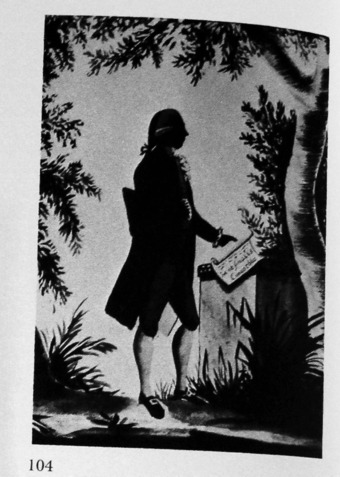
COSTUME DATING POINTS
The wig, possibly a pigtail, with a distinct separation between the starting wings toupée and the back hair; a buckle is also shown.
The pre-1785 stock.
The breeches, ending just below the knee and secured at the knee by buttons as well as (probably) by stings below the knee. The waistcoat, of the type with skirts, not square-cut; patterned in the horizontal stripes which were fashionable.
The round-toed shoes, worn with rectangular buckles and not with the strings or laces which were not to begin to come into fashion until 1785.
From Weymer Mills, 'One Hundred Silhouettes from Wellesley Collection' (1912), by courtesy of the Oxford University Press.
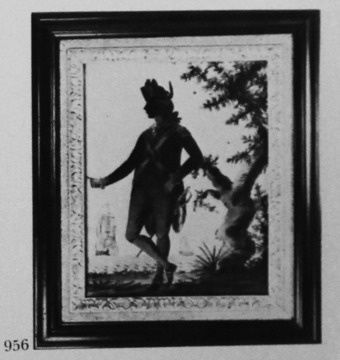
Unknown naval officer.
Silhouette painted on card 1781
10 x 8in. / 254 x 204mm.
Frame: ebonised wood, with ormolu surround.
This silhouette is signed near the base of the tree-trunk, 'W. Wellings fecit, 1781.'
M. A. H. Christie collection.

Two unknown women
Silhouette painted on paper 1782
7¾ x 9¾in. / 108 x 248mm.
A well known example of the artist's full-length work. The out-of-date hair-style worn by the woman on the right illustrates the difficulty of dating undated silhouettes of the older sitters.
Signed 'W. Wellings fecit, 1782'.
Crown Copyright. Victoria and Albert Museum, No. P123.1922
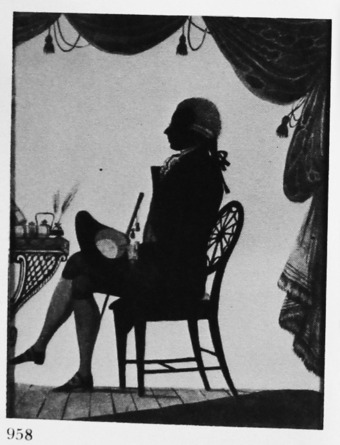
Henry Belasyse, fifht Earl of Fauconberg
Silhouette painted on card in shades of grey, dark brown and black
c. 1782-84
10 x 8in. / 254 x 204mm.
The earl was Lord of the Bedchamber to George III and Lord-Lieutenant of the North Riding of Yorkshire. The Royal family stayed in his house in Cheltenham during their visit to the town in 1788. The rendering of the looped curtain (apparently made of moiré silk) is especially fine.
Despite the apparent absence of a signature, the attribution of this piece to Welling is beyond doubt.
From the collection of the late J. C. Woodiwiss

Unknown naval officier
Silhouette painted on paper
1783
10 x 8in. / 254 x 204mm.
Frame: ebonised wood, with ormolu surround.
The subject's pose (three-quarter facing, with the head turned to show the profile) is typical of most of the artist's full-length single-figure compositions. The silhouette is signed on the distant hills in the background, 'W. Wellings fecit, 1783'.
J. A. Pollak collection

The Reverend George Austen presenting Edward Austen to Mr and Mrs Thomas Knight
Group silhouette painted on paper in tones of grey, with the background in sepia wash
1783.
11 x 12½in. / 280 x 445mm.
A well known silhouette of a family group by Wellings. Mr and Mrs Knight adopted young Edward Austen as their heir. Signed 'W. Wellings fecit, 1783'
By courtesy of Major E. Knight
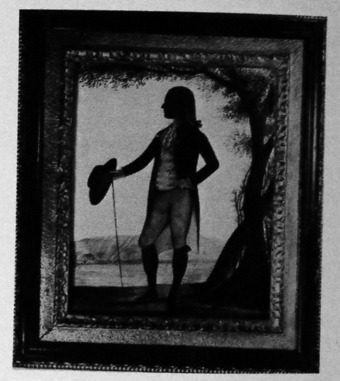
Unknown country gentleman
Silhouette painted on card
? c. 1785
10 x 8in. / 254 x 204mm.
The date is suggested by the signs that the sitter is wearing with a cravat with a bow, which did not come into fashion until this year. Though the silhouette is apparently unsigned, its attribution to Wellings is indisputable.
M. A. H. Christie collection
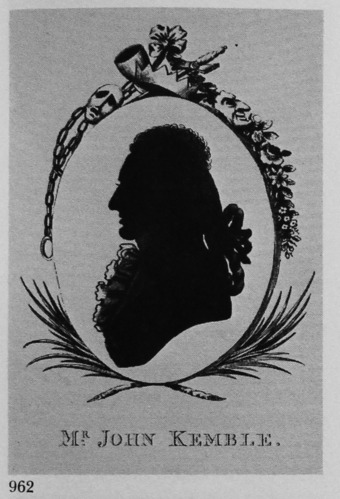
John Philip Kemble
silhouette print
Date of silhouette: c. 1784
It is safe to assume that this print was engraved and published by Wellings (see the text).
Author's collection

Duke of York
silhouette print
Date of publication of print: 8 October1793.
Engraved and published by Wellings's address at 26 Henrietta Street.
National Portrait Gallery, London, No. 94 p.7
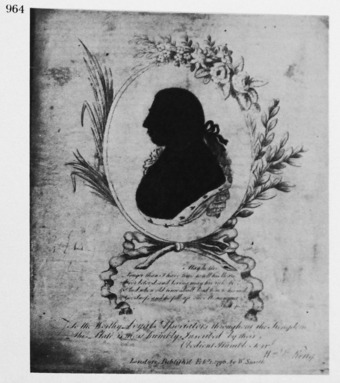
George III
silhouette print
Date of publication of print: 1 February 1796
It is safe to assume that this print was engraved by Wellings after on of his own silhouettes (see text). The inscription read as follows:
May He live,
Longer than I have time to tell his Years!
Ever belov'd and lovving may his rule be!
And when old time shall lead him to his end.
Goodness and he fill up one Monument
SHAKESPEARE
To the Worthy Loyal Associators throughout the Kingdom
This Plate is Most Humbly Inscribed by their Obedient Humble Servt.
Wm. Wellings.
London, Published Feb. 1st., 1796, by W. Smith.
By gracious permission of Her Majesty the Queen
